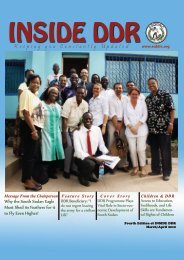Examining Enterprise Capacity - SSDDRC
Examining Enterprise Capacity - SSDDRC
Examining Enterprise Capacity - SSDDRC
You also want an ePaper? Increase the reach of your titles
YUMPU automatically turns print PDFs into web optimized ePapers that Google loves.
Before the war, Juba was a centre for trade in Southern Sudan. Currently, Juba is host to many GOSS<br />
ministries and agencies, as well as a wide range of international governmental and nongovernmental<br />
organizations. The soil and climate around Juba are suitable for the growth of a variety<br />
of crops, vegetables and fruits. There are likewise other natural resources available to local people.<br />
The Nile River can be used for irrigation, drinking water, as a source of fresh fish and to generate<br />
hydro-electric power. Poor roads and transportation difficulties make the rainy season, from May/<br />
June to September, a challenging time of year for locals with regards to trade and other forms of<br />
income generation 10 .<br />
General Observations<br />
Juba<br />
Upon arrival in Juba, the contrast in development of basic infrastructure compared with Khartoum<br />
was clear. The few main roads that are cleared of landmines are in terrible condition and<br />
unmanageable without a 4x4 vehicle. Public transport services are poor and do not service all areas<br />
of town, leaving local residents to walk long distances to reach their destinations. Infrastructure in<br />
general is inadequate in meeting the needs of the population – power supply is not continuous and<br />
very limited, buildings are at the fringe of collapse, clean water is scarce and health and public<br />
services are almost non-existent for the majority of residents. This poses gender-specific implications<br />
for both women and men.<br />
There is an enormous presence of the UN officials and NGO staff in Juba. Since the signing of the<br />
CPA, the Juba area has experienced an influx of economic and other activity due to what many call<br />
an ‘NGO invasion’ and the presence of a large number of Kenyan and Ugandan businesspeople. This<br />
has put pressure on the IDPs and residents of Juba, as their access to surrounding land and<br />
resources is restricted and price of commodities in the local markets has skyrocketed. Hundreds of<br />
new 4x4 vehicles are roaming the roads carrying the international development community from<br />
GOSS offices to the UN compound and accommodation locations. . Local accommodation has been<br />
unable to keep up with demand. Renting a tent for the night costs approximately $150 USD and<br />
meals at restaurants serving the non-residents cost approximately $15 USD per person. A car with<br />
driver costs a minimum of $100 USD per day. At the time of the study, the price of bottled water in<br />
the local market was six times that of bottled water found in Khartoum. These extraordinary prices<br />
are a direct result of the infusion of aid workers and development funds. . . . One NGO director stated<br />
that the ‘Juba miracle’ is that residents are still able to survive.<br />
A lot of construction has commenced in Juba, much of it focused on buildings and infrastructure to<br />
service donor agencies. Development funds, other than the cost of UN and NGO salaries, vehicles<br />
and buildings, have been focused on capacity building for the government ministries, including<br />
constitutions, legal documents and training. These important efforts are unfortunately not seen by<br />
most local residents. The banking sector appears quite active. However, the researchers found the<br />
southern-based Nile Bank to be one of the only financial institutions to truly have a vision and desire<br />
for the provision of microfinance to all women, men and children in the community.<br />
Relations between different ethnic groups in Juba, and in much of Southern Sudan, have yet to be<br />
normalized. The hardships of the long war and the accumulation of ethnic, gender, racial and<br />
religious divides advocated by both the GOS and SPLM are still affecting the mindsets of the<br />
population.<br />
10 Ibid<br />
19


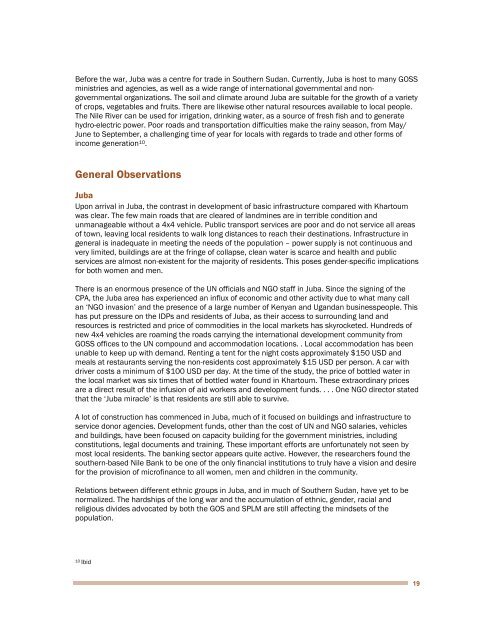
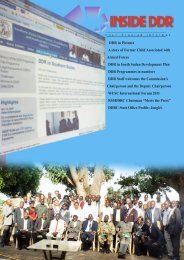
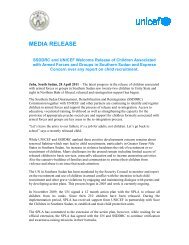
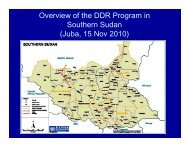
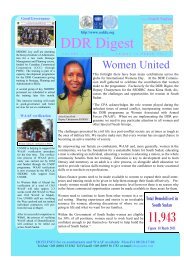
![Download here [975KB] - Republic of South Sudan DDR Commission](https://img.yumpu.com/10592740/1/184x260/download-here-975kb-republic-of-south-sudan-ddr-commission.jpg?quality=85)
